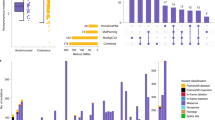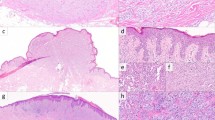Abstract
Analysis of 501 melanoma exomes identified RASA2, encoding a RasGAP, as a tumor-suppressor gene mutated in 5% of melanomas. Recurrent loss-of-function mutations in RASA2 were found to increase RAS activation, melanoma cell growth and migration. RASA2 expression was lost in ≥30% of human melanomas and was associated with reduced patient survival. These findings identify RASA2 inactivation as a melanoma driver and highlight the importance of RasGAPs in cancer.
This is a preview of subscription content, access via your institution
Access options
Subscribe to this journal
Receive 12 print issues and online access
$209.00 per year
only $17.42 per issue
Buy this article
- Purchase on Springer Link
- Instant access to full article PDF
Prices may be subject to local taxes which are calculated during checkout

Similar content being viewed by others
References
Siegel, R., Naishadham, D. & Jemal, A. CA Cancer J. Clin. 62, 283–298 (2012).
Hodis, E. et al. Cell 150, 251–263 (2012).
Krauthammer, M. et al. Nat. Genet. 44, 1006–1014 (2012).
Krauthammer, M. et al. Nat. Genet. 47, 996–1002 (2015).
Flaherty, K.T. et al. N. Engl. J. Med. 363, 809–819 (2010).
Chapman, P.B. et al. N. Engl. J. Med. 364, 2507–2516 (2011).
Lemmon, M.A. & Schlessinger, J. Cell 141, 1117–1134 (2010).
Vivanco, I. & Sawyers, C.L. Nat. Rev. Cancer 2, 489–501 (2002).
Sjöblom, T. et al. Science 314, 268–274 (2006).
Vogelstein, B. et al. Science 339, 1546–1558 (2013).
Maertens, O. & Cichowski, K. Adv. Biol. Regul. 55, 1–14 (2014).
Miao, W., Eichelberger, L., Baker, L. & Marshall, M.S. J. Biol. Chem. 271, 15322–15329 (1996).
Rodriguez-Viciana, P., Oses-Prieto, J., Burlingame, A., Fried, M. & McCormick, F. Mol. Cell 22, 217–230 (2006).
Kiel, C., Verschueren, E., Yang, J.S. & Serrano, L. Sci. Signal. 6, ra109 (2013).
Ko, L.J. & Prives, C. Genes Dev. 10, 1054–1072 (1996).
Papa, A. et al. Cell 157, 595–610 (2014).
Fang, J.Y. & Richardson, B.C. Lancet Oncol. 6, 322–327 (2005).
Mann, G.J. et al. J. Invest. Dermatol. 133, 509–517 (2013).
Jayawardana, K. et al. Int. J. Cancer 136, 863–874 (2015).
Wei, X. et al. Nat. Genet. 43, 442–446 (2011).
Dutton-Regester, K. et al. Oncotarget 5, 2912–2917 (2014).
Palavalli, L.H. et al. Nat. Genet. 41, 518–520 (2009).
Solomon, D.A. et al. Cancer Res. 68, 10300–10306 (2008).
Scheffzek, K. et al. Science 277, 333–338 (1997).
Acknowledgements
We thank T. Wiesel for graphical assistance. This work was supported by the Intramural Research Programs of the National Human Genome Research Institute and the National Cancer Institute, as well as by program grants of the Australian National Health and Medical Research Council (NHMRC) and Cancer Institute NSW. Y.S. is supported by the Israel Science Foundation through grants 1604/13 and 877/13, the European Research Council (ERC; StG-335377), the ERC under the European Union's Horizon 2020 research and innovation program (grant agreement 677645), the Henry Chanoch Krenter Institute for Biomedical Imaging and Genomics, the estate of Alice Schwarz-Gardos, the estate of John Hunter, the Knell Family, the Peter and Patricia Gruber Award and the Hamburger Family. I.U. is supported by a grant from the Rising Tide Foundation. N.K.H., K.D.-R. and R.A.S. are supported by fellowships from the NHMRC. A.L.P. is supported by Cure Cancer Australia. Support from the Melanoma Institute Australia is also gratefully acknowledged. We thank the TCGA Research Network for generating some of the data sets.
Author information
Authors and Affiliations
Contributions
R.A., N.Q., R.E., A.K.-P., J.J.G. and Y.S. designed the study. J.M., A.E., J.S.W., J.J.G., K.D.-R., P.J., A.L.P., N.W., G.J.M., R.A.S., N.K.H. and S.A.R. collected and analyzed the melanoma samples. S.S., R.R., J.C.L., J.K., S.B.-D. and I.U. analyzed the genetic data. R.A., R.E., S.W.-K., V.K.H., Y.H. and J.M. performed the functional experiments and analyzed the data. A.D.P. and M.Y.N. performed the structural analysis. All authors contributed to the final version of the manuscript.
Corresponding author
Ethics declarations
Competing interests
The authors declare no competing financial interests.
Supplementary information
Supplementary Text and Figures
Supplementary Figures 1–9 and Supplementary Tables 4–8. (PDF 1259 kb)
Supplementary Table 1
Somatic mutations identified in 501 melanoma whole exomes and whole genomes. (XLSX 68530 kb)
Supplementary Table 2
Statistical calculation of significance of the somatic mutations identified in 499 melanoma whole exomes/genomes. (XLSX 522 kb)
Supplementary Table 3
Mutations identified in samples with RASA2 mutations. (XLSX 201151 kb)
Rights and permissions
About this article
Cite this article
Arafeh, R., Qutob, N., Emmanuel, R. et al. Recurrent inactivating RASA2 mutations in melanoma. Nat Genet 47, 1408–1410 (2015). https://doi.org/10.1038/ng.3427
Received:
Accepted:
Published:
Issue Date:
DOI: https://doi.org/10.1038/ng.3427
This article is cited by
-
Targeting ferroptosis in melanoma: cancer therapeutics
Cell Communication and Signaling (2023)
-
Current understanding of epigenetics role in melanoma treatment and resistance
Cancer Cell International (2022)
-
Plant miR171 modulates mTOR pathway in HEK293 cells by targeting GNA12
Molecular Biology Reports (2021)
-
Integrated molecular drivers coordinate biological and clinical states in melanoma
Nature Genetics (2020)
-
Multi-omic analysis reveals significantly mutated genes and DDX3X as a sex-specific tumor suppressor in cutaneous melanoma
Nature Cancer (2020)



